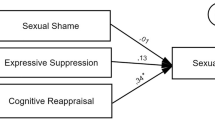Abstract
The present study explored effects of emotional states on sexual desire and dysfunction. Three basic emotion dimensions, pleasure-displeasure, arousal-nonarousal, and dominance-submissiveness, served as the independent factors. Factor analysis of a sexual desire and problems questionnaire yielded a single factor with sexual desire as one pole and sexual problems as the opposite pole. The resulting “sexual desire” scale had a KR-20 reliability coefficient of .98 and constituted a highly homogeneous dependent measure. Sexual desire was greater when subjects felt pleasure rather than displeasure, unaroused rather than aroused, and dominant rather than submissive. Desire increased with increasing arousal in pleasant states and decreased with increasing arousal in unpleasant states (Pleasure × Arousal interaction). Desire increased with increasing dominance in pleasant states and decreased with increasing dominance in unpleasant states (Pleasure × Dominance interaction). In unaroused states, submissiveness attenuated the polarization of sexual desire as a function of pleasure-displeasure (Pleasure × Arousal × Dominance interaction). The highest levels of sexual desire and freedom from sexual problems were associated with pleasant and dominant feelings (e.g., admired and vigorous or relaxed and leisurely); the lowest levels were reported for unpleasant and aroused feelings (e.g., hostile and hateful or pained and embarrassed). Except for the uniformly greater sexual desire of males than of females across all conditions, all findings were applicable equally to the two sexes.
Similar content being viewed by others
References
Derogatis, L., & Meyer, J. K. (1979). A psychological profile of the sexual dysfunctions.Archives of Sexual Behavior, 8 201–223.
Eichler, E. (1976).Self disclosure, affiliation, and social judgments as functions of emotional responses in settings. Unpublished doctoral dissertation, University of California, Los Angeles.
Eysenck, H. J. (1976).Sex and personality. Austin: University of Texas Press.
Frauman, D. C. (1982). The relationship between physical exercise, sexual activity, and desire for sexual activity.Journal of Sex Research, 18 41–46.
Gillman, M. A., & Lichtigfeld, F. J. (1983). The effects of nitrous oxide and naloxone on orgasm in human females: A preliminary report.Journal of Sex Research, 19 49–57.
Hines, M., & Mehrabian, A. (1979). Approach-avoidance behaviors as a function of pleasantness and arousing quality of settings and individual differences in stimulus screening.Social Behavior and Personality, 7 223–233.
Kuder, G. F., & Richardson, M. W. (1937). The theory of estimation of test reliability.Psychometrika, 2 151–160.
Lange, J. D., Wincze, J. P., Zwick, W., Feldman, S., & Hughes, K. (1981). Effects of demand for performance, self-monitoring of arousal, and increased sympathetic nervous system activity on male erectile response.Archives of Sexual Behavior, 10 443–464.
Lazarus, A. A. (1972). Psychological causes of impotence.Sex Behavior, 2 39–42.
Malatesta, V. J., Pollack, R. H., Crotty, T. D., & Peacock, L. J. (1982). Acute alcohol intoxication and female orgasmic response.Journal of Sex Research, 18 1–17.
Mehrabian, A. (1976).Public places and private spaces: The psychology of work, play, and living environments. New York: Basic Books.
Mehrabian, A. (1978). Measures of individual differences in temperament.Educational and Psychological Measurement, 38 1105–1117.
Mehrabian, A. (1980).Basic dimensions for a general psychological theory: Implications for personality, social, environmental, and developmental studies. Cambridge, Massachusetts: Oelgeschlager, Gunn & Hain.
Mehrabian, A. (1981).Silent messages: Implicit communication of emotions and attitutdes. Belmont, California: Wadsworth.
Mehrabian, A., & Bekken, M. L. (1985).Temperament characteristics of individuals who participate in strenuous sports. Unpublished manuscript, Department of Psychology, UCLA.
Mehrabian, A., & Russell, J. A. (1975). Environmental effects on affiliation among strangers.Humanitas, 11 219–230.
Russell, J. A., & Mehrabian, A. (1975). The mediating role of emotions in alcohol use.Journal of Studies on Alcohol, 36 1508–1536.
Russell, J. A., & Mehrabian, A. (1977a). Evidence for a three-factor theory of emotions.Journal of Research in Personality, 11 273–294.
Russell, J. A., & Mehrabian, A. (1977b). Environmental effects on drug use.Environmental Psychology and Nonverbal Behavior, 2 109–123.
Snyder, D. K., & Berg, P. (1983). Determinants of sexual dissatisfaction in sexually distressed couples.Archives of Sexual Behavior, 12 237–246.
Sue, D. (1979). Erotic fantasies of college students during coitus.Journal of Sex Research, 15 299–305.
Author information
Authors and Affiliations
Rights and permissions
About this article
Cite this article
Mehrabian, A., Stanton-Mohr, L. Effects of emotional state on sexual desire and sexual dysfunction. Motiv Emot 9, 315–330 (1985). https://doi.org/10.1007/BF00992203
Issue Date:
DOI: https://doi.org/10.1007/BF00992203




